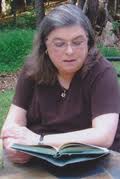Short Bio
B.K. Stevens writes mysteries, both novels and short stories. Interpretation of Murder, published by Black Opal Books, is a traditional whodunit; Fighting Chance, set in Virginia, is a martial arts mystery for young adults and was published by Poisoned Pen Press. B.K. has also published over fifty short stories, most in Alfred Hitchcock’s Mystery Magazine. Eleven of those stories are collected in Her Infinite Variety: Tales of Women and Crime, published by Wildside Press. She has won a Derringer and has been nominated for Agatha, Anthony, and Macavity awards. B.K. and her husband live in Virginia and have two grown daughters.
Longer Bio
B.K. (Bonnie) Stevens writes mysteries, both novels and short stories. Her first novel, Interpretation of Murder, published by Black Opal Books, is a traditional whodunit that offers readers insights into deaf culture and sign-language interpreting. Her second novel, Fighting Chance, a martial arts mystery for young adults, is set in Virginia and was published by Poisoned Pen Press. One Shot, a satirical e-novella published by Untreed Reads, takes on issues ranging from gun control to reality shows. B.K. has also published over fifty short stories, most of them in Alfred Hitchcock’s Mystery Magazine. Eleven of her stories are collected in Her Infinite Variety: Tales of Women and Crime, published by Wildside Press. B.K. has won a Derringer from the Short Mystery Fiction Society and has been nominated for Agatha, Anthony, and Macavity awards. One of her stories made the list of “Other Distinguished Stories” in Best American Mystery Stories 2013, and another won a suspense-writing contest judged by Mary Higgins Clark. B.K. has also published three nonfiction books (Holt, Harcourt, and Behrman House), along with articles in The Writer, Mystery Readers Journal, and The Third Degree. She blogs at SleuthSayers and also hosts The First Two Pages. B.K. and her husband live in Virginia and have two grown daughters.
Biographical Essay
Ever since I can remember, I’ve had two career goals: I’ve wanted to teach, and I’ve wanted to write. Life has been kind, and I’ve had many opportunities to do both.
Growing up in Buffalo, New York, I wrote countless stories, poems, and plays. Once I arrived at Kenyon College in Gambier, Ohio, however, I got caught up in studying literature and put creative writing aside for a while–as it turned out, for a long while. College also brought another reason to neglect writing: my future husband, Dennis Stevens. We got married two weeks after graduation and headed for Boston College, where he earned a Ph.D. in political science and I earned one in English. A series of teaching jobs followed, at colleges and universities in New Jersey, Ohio, Illinois, Maryland, South Dakota, and Virginia. For four years, I taught at an Orthodox Jewish high school in Cleveland–quite an interesting experience for a Reform Jew. Along the way, I did some academic writing, including a composition textbook (Holt) and a guide to literary criticism and research (Harcourt). But teaching was more absorbing than writing–and so were our daughters, Sarah and Rachel. As I became increasingly involved in their religious education, first as a volunteer teacher and then for five years as a Sunday school principal, I did a lot of reading and thinking about Jewish education and ended up writing a book for Behrman House.
While I was dividing my time between motherhood, religious school, and teaching a lot of composition classes as an adjunct, the old dream of being a fiction writer kicked in again. I’d been a mystery fan ever since spending a summer at Oxford and reading Dorothy Sayers’s wonderful Oxford mystery, Gaudy Night; could I try to write mysteries myself? My first attempt was a novel that never got published (now, I understand why). So I turned to short stories.
The first three stories went nowhere, but the fourth found a home at Alfred Hitchcock’s Mystery Magazine. “True Detective” introduced the team of Lieutenant Walt Johnson and Sergeant Gordon Bolt and began a twelve-story series that ended with “True Enough” in December, 2014. Other series characters for Hitchcock include private detective Iphigenia Woodhouse and amateur sleuth/temporary secretary Leah Abrams. I’ve also published a number of stand-alone stories, including one that won a Derringer award for Best Long Story in 2011. “Thea’s First Husband,” published in Hitchcock in 2012, was nominated for Agatha and Macavity awards and also made the list of “Other Distinguished Stories” in Best American Mystery Stories. In all, Hitchcock has published over thirty of my stories, some of which have been reprinted in anthologies such as Women of Mystery I, II, and III. Add over half a dozen stories for Woman’s World and a story called “The Good Listener,” which won a suspense-writing contest judged by Mary Higgins Clark and appeared in Family Circle, some stories for anthologies, an e-story and an e-novella called One Shot for Untreed Reads–it’s been fun, and it’s felt satisfying.
The old dream of publishing a novel never died. Now, it’s come true–twice. In April, 2015, Black Opal Books published Interpretation of Murder, a hard-edged traditional mystery featuring American Sign Language interpreter Jane Ciardi. And in October, The Poisoned Pencil, the new young adult imprint of Poisoned Pen Press, will publish Fighting Chance, a martial arts mystery for teens. I’m excited about this new phase in my writing career and hope it’s just the beginning.
I’m now living in Hampden-Sydney, Virginia, building an empty nest with Dennis, and taking a few years (at least) off from teaching to focus on writing. I hope many more stories and novels lie ahead–and perhaps a short-story collection, too.
